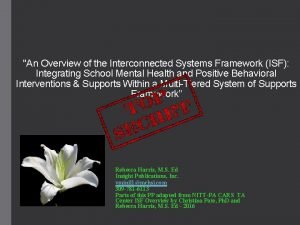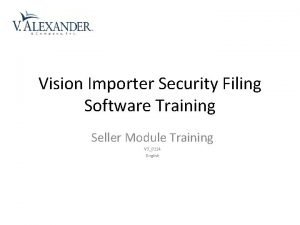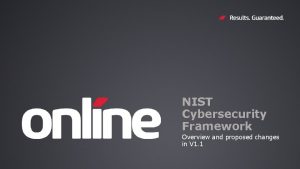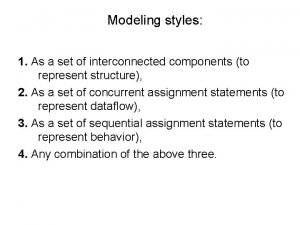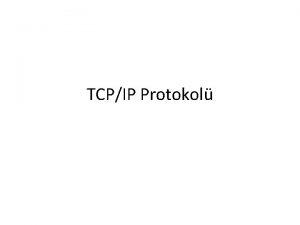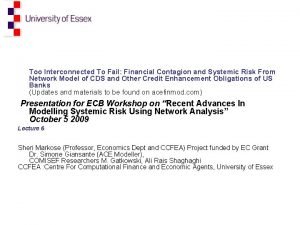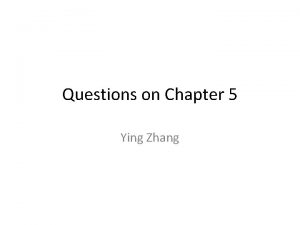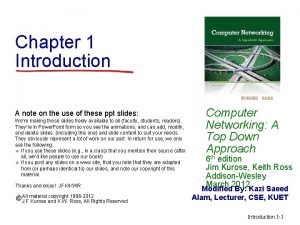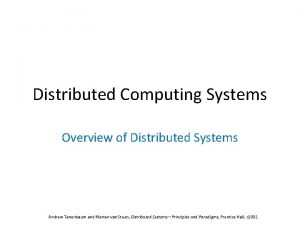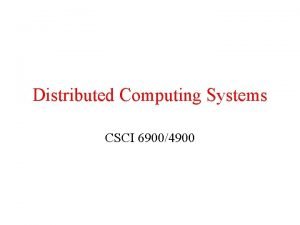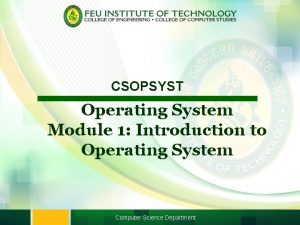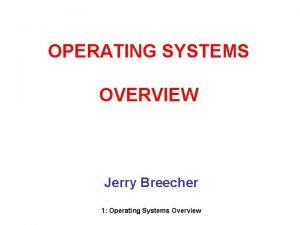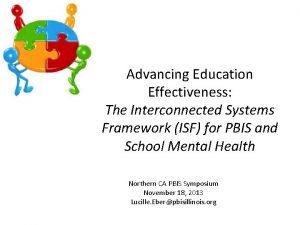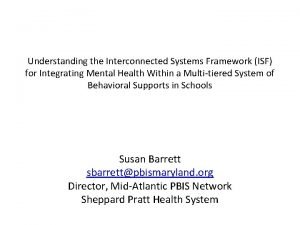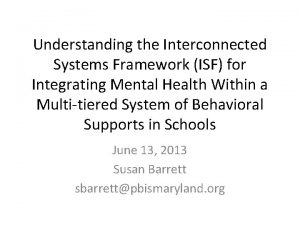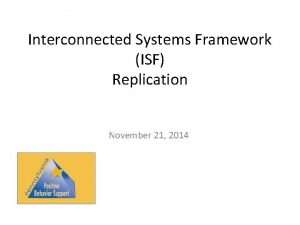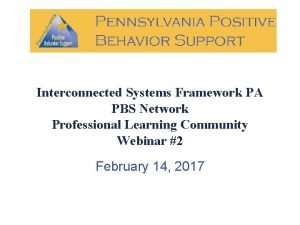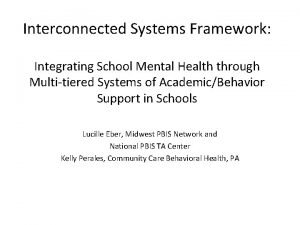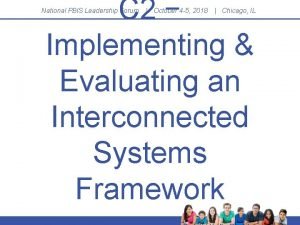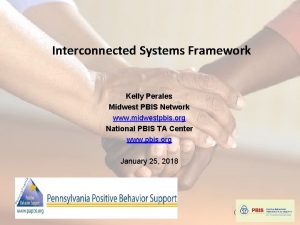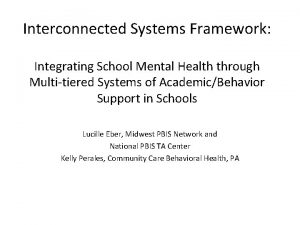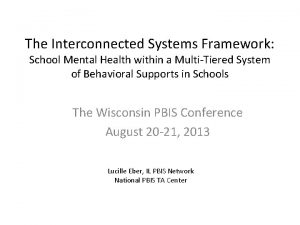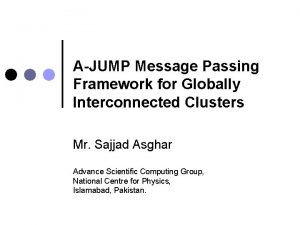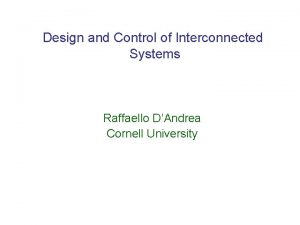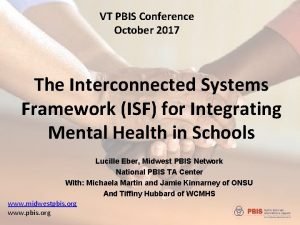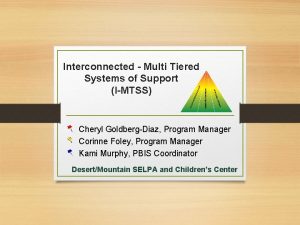An Overview of the Interconnected Systems Framework ISF






















































- Slides: 54

"An Overview of the Interconnected Systems Framework (ISF): Integrating School Mental Health and Positive Behavioral Interventions & Supports Within a Multi-Tiered System of Supports Framework” Rebecca Harris, M. S. Ed Insight Publications, Inc. yminil 1@mchsi. com 309 -781 -6113 Parts of this PP adapted from NITT-PA CARS TA Center ISF Overview by Christina Pate, Ph. D and Rebecca Harris, M. S. Ed - 2016

SAMHSA’s NITT PA & MT… Christina Pate, Ph. D Rebecca Harris, M. S. Ed Technical Assistance Liaison (TAL) via CARS TA Center Consultant & Subject Matter Expert via CARS TA Center Email: cpate@wested. org Email: yminil 1@mchsi. com Phone: 562. 799. 5423 Phone: 309. 781. 6113

SAMHSA’S “NOW IS THE TIME” INITIATIVES Making schools safer. PRESIDENT’S “NOW IS THE TIME” PLAN Increasing access to mental health services. SAMHSA’S “NOW IS THE TIME” INITIATIVES PROJECT AWARE HEALTHY TRANSITIONS PROJECT AWARE SEA PROJECT AWARE LEA PROJECT AWARE-C PROJECT AWARE SEA-LEA (LOCAL LABS) 3

Through active participation, Agents will: Increase their understanding of a Multi-Tiered System of Supports (MTSS) framework Increase their understanding of the critical features and rationale behind the ISF Increase their understanding of how installing ISF following the steps of implementation science can cause their work serving children, families, and communities to be more effective Apply ISF pilot sites examples to their own work serving children, families, and communities Identify and select tools to assess and assist their capacity in developing and implementing the ISF by merging PBIS (MBI) and SMH within a MTSS framework Strategically plan their ISF efforts within their respective state teams

Before We Get Started… To clarify: ISF is just ONE way to organize and frame your multiple initiatives within a MTSS framework This training will help you break down the concepts of ISF and apply it to your specific districts/communities This is NOT a substitute for MBI or SMH training Due to the varying levels of knowledge and implementation, this training provides an overview of ISF 5

Field Agents inventory… 0 -1 -2 -3 for MBI implementation 0 -1 -2 -3 for SMH implementation 0 -1 -2 -3 for ISF implementation 6

Differentiated tasks for participants sisep. fpg. unc. edu Stage of implementation What it looks like Task for today EXPLORATION Assessing needs, examining intervention • components, considering implementation • drivers, assessing fit • INSTALLATION Acquiring resources, preparing organization, preparing implementation drivers, preparing staff • Adjusting implementation drivers, managing change, deploying data systems, initiating improvement cycles • • INITIAL IMPLEMENTATION • • • FULL IMPLEMENTATION Monitoring and managing • implementation drivers, achieving fidelity • and outcome benchmarks, further • improving fidelity and outcomes Exposure Strengths/barriers Determining if you need it Taking inventory of your readiness What do you have/still need? Are all voices impacted at the table? Assessing launch to date What’s going well/needs help with your data, systems, & practices? What does your data say? Has it become systemic? Are you achieving your goals? What other initiatives can be incorporated into your system? Implementation drivers = 1) Competency (coaching, training, selection) 2) Organization (systems interventions, facilitative administration, data system) 3) Leadership (technical, adaptive) 7

Code names… • PBIS – Positive Behavioral Interventions & Supports (AKA MBI in MT!!!) • MTSS – Multi-Tiered System of Supports • SMH – School Mental Health • SOC – Systems of Care • IS – Implementation Science 8

ISF: The What & the Why

What is an Interconnected Systems Framework & why do we need it? Adapted from Ohio Project AWARE Brief No. 1: March 2015 • Represents the structure and process of the interconnection between MTSS (like PBIS) and SMH • Strategically aligns and streamlines the goals, processes, and resources of PBIS & SMH • Addresses gaps and limitations of both PBIS & SMH • Improves student and systems functioning PBIS + SMH = ISF 10

Origin of the ISF (since 2008) • University of MD Center for School Mental Health and OSEP National Technical Assistance Center on PBIS worked to link SMH & PBIS • Concept paper developed to stimulate dialogue at national conferences, meetings and across partners in 4 states • Collaborative is learning from schools currently implementing ISF (10 districts across 6 states) • Examples and pilot sites discussed extensively in the Monograph https: //www. pbis. org/school-menta -health/interconnected-systems 11

LIE DETECTOR TEST… We have both MBI and SMH supports in my district. We must have an ISF. FALSE!!! • Although both might exist, they may not be integrated together. • Both might exist throughout your district but not both within every building in your district. 12

Why should we invest in using an Interconnected Systems Framework? • Leverages and integrates the individual strengths of both MBI & SMH • Addresses gaps and limitations of both MBI & SMH when used independently • Improves outcomes for students through earlier access to wider range of evidencebased practices • Increases systems functioning within school + community MH + families • Allows for wide scope of outcomes to be analyzed: • individual student • grade levels • building • district • community • Cross-system training promotes increased understanding & communication • Decreases stigma due to availability of services across settings – continuum of care Ohio Project AWARE Brief No. 1: March 2015 ISF Final Monograph: Barrett, S. , Eber, L. , & Weist, M. (Eds). (2013) Advancing Education Effectiveness: Interconnecting School Mental Health and School-Wide Positive Behavior Support 13

LIE DETECTOR TEST… Our district has someone that sits on various interdisciplinary teams, committees, or workgroups to help improve outcomes for students. We must have an ISF. FALSE!!! • ISF = MBI + SMH • MBI is an example of a MTSS (multi-tiered system of supports) • By having MBI in the above equation, it is assumed that MBI and SMH are blended by utilizing MTSS principles to form an ISF (holy acronyms!) 14

MONTANA AGENTS: HANG ONTO YOUR HATS & FIND YOUR CANDY CONTACT. 15

What is a Multi-Tiered System of Supports Who can give me (MTSS)? common MTSS Background: Stems from the Public Health Model Key Components: examples in a school setting? What else could you organize in a MTSS framework? • Framework not a curriculum • Multi-tiered continuum of supports guided by qualifying decision rules: Tier 1: On-going, proactive and preventative for entire population Tier 2: As needed, large and small groups, some individualization for some of the population Tier 3: Highly individualized for increased duration, intensity, frequency • Core + more • Use of evidence-based practices • Data used to assess, progress monitor, problem-solve • Stakeholder engagement • Culturally relevant and appropriate 16

Let’s investigate this… ISF = SMH: MBI (example of MTSS): • WHO: All students • WHAT: Continuum of MH • WHAT: Continuum of supports behavioral supports • WHERE: In school • WHEN: As needed • HOW: School-based and community-based providers • THROUGH: application of MTSS framework principles 17

How the MTSS framework principles impact MBI: MBI (example of MTSS): MTSS applied principles: WHO: All students All staff and students including SPED WHAT: Continuum of behavioral supports Tier 1, 2, 3 of evidence-based behavioral supports developed to fit individual school population needs WHERE: In school + home, community as indicated WHEN: Tier 1 – always; Tiers 2 & 3 as Data-driven as indicated by decision rules needed between Tiers that encompass whole child HOW: School-based and communitybased providers District and building systems are developed; tiered teams comprised of all impacted parties. 18

Pros and Cons of MBI & SMH Ohio Project AWARE Brief No. 1: March 2015 ISF Final Monograph: Barrett, S. , Eber, L. , & Weist, M. (Eds). (2013) Advancing Education Effectiveness: Interconnecting School Mental Health and School-Wide Positive Behavior Support MBI PROS SMH CONS Decreased problem behaviors May not fully address the emotional needs of all students with more complex MH issues Improved school climate Resources and structures at the upper tiers are less welldeveloped and validated Improved attendance Less well-developed and validated in high schools Improved academic achievement Improved social competence PROS CONS Early identification of possible conditions Difficulty implementing SMH programs due to too few staff with too many additional duties Improved prevention strategies Lack of integration among school-based and community providers Improved service access Unrefined use of data to drive decisionmaking Decreased MH stigma Spreads service impact 19

AGENTS: ESTABLISH EYE CONTACT PARTNER DEFINE HOW THIS NEW APPLICATION OF MTSS COULD SHAPE THE FUTURE OF MONTANA THIS MESSAGE WILL SELF-DESTRUCT IN 2 MINUTES 2

ISF: The How


PBIS(MBI): Multi-Tiered System of Supports (MTSS) Framework Behavioral Systems Academic Systems Tier 3/Intensive Interventions 1 -5% • Individual students • Assessment-based • High intensity Tier 2/Targeted Interventions 5 -15% • Some students (at-risk) • High efficiency • Rapid response • Small group interventions • Some individualizing Tier 1/Universal Interventions 80 -90% 1 -5% Tier 3/Intensive Interventions • Individual students • Assessment-based • Intense, durable procedures 5 -15% Tier 2/Targeted Interventions • • • Some students (at-risk) High efficiency Rapid response Small group interventions Some individualizing 80 -90% Tier 1/Universal Interventions • All settings, all students • Preventive, proactive • All students • Preventive, proactive Presented with academics b/c it’s installed in school; encourages whole-child view (behavior, academics, mental health, physical health, social emotional learning) Core + more model IAdapted from “What is school-wide PBS? ” OSEP Technical Assistance Center on Positive Behavioral Interventions and Supports. Accessed at http: //pbis. org/school-wide. htm Early identification & intervention Kids responding to environment 23

PBIS (MBI): Social Competence & Academic Achievement for ALL Kids OUTCOMES Supporting Staff Behavior SYSTEMS DATA Supporting Decision Making PRACTICES Adapted from “What is a systems approach in school-wide PBS? ” OSEP Technical Assistance on Positive Behavioral Interventions and Supports. Accessed at http: //www. pbis. org/schoolwide. htm Supporting Student Behavior 24

IOWA MTSS MODEL Tier 1: Universal Tier 2: Check In Check Out With Modified Features &/OR Tier 2: Social/Academic Instructional Groups Tier 2: Check & Connect &/OR Tier 3: Brief Functional Behavior Analysis. Behavior Intervention Plan Tier 3: Complex Functional Behavior Analysis – Behavior Interventio n Plan &/OR Tier 3: Wraparound Two ways that students are placed into the continuum of interventions: 1. Bottom up: students are identified through decision rules as needing additional level supports. 2. Immediate need: students present as needing higher level supports right away and are placed in appropriate intervention based on meeting decision rule criteria 25

IOWA PBIS MTSS MODEL of EVIDENCE-BASED PRACTICES TIER/TYP E TIER 1/UNIVERSAL: ALL STUDENTS/STAFF FUNCTION-INFORMED INTERVENTION 100% of students receive EVIDENC E-BASED PRACTIC ES Universal PBIS: • • Direct instruction of behavior • • Reinforcement of desired behaviors • Pre-correction • • Re-teaching Check-In Check Out (CICO) Check-in Check Out With Modified Features (CICOWMF) Social Academic Instructional Groups (SAIG) DURATIO N/ FREQUEN CY PER CYCLE • CICO & CICOWMF: 4 - • 6 weeks/15 minutes throughout day SAIG: 4 -6 weeks/30 min block 1 -2 x a week DATA REVIEW • MAIN /OTHER FUNCTIO NS MET MAIN: Obtain adult attention OTHER: Obtain All year/daily TIER 2/TARGETED: LARGE/SMALL FUNCTIONINFORMED GROUPS • • Monthly • TIER 2 /TARGETED: INDIVIDUALIZED FUNCTION-INFORMED INTERVENTIONS TIER 3/INTENSIVE: HIGHLY INDIVIDUALIZED, FUNCTION-BASED INTERVENTIONS 1 -5% of students access 5 -15% of students access 1 -2 x/month • • Individualized Adult- • Student Mentoring: • (Check & Connect) • C&C: 2 years/weekly 30 minutes minimum per student based on data outcomes • 2 x/month + as needed • MAIN: Obtain adult attention OTHER: Obtain access to individualized to meet • Brief FBA/BIP Complex FBA/BIP Wraparound • Embed in all of the above: Individualized CICO (WMF) , SAIG, C&C BFBA/BIP: 4 -6 weeks + /daily CFBA/BIP & WA: high frequency/structure until progress made Weekly + as needed MAIN: Individualized to meet function(s) at a higher intensity, 26

WHAT’S THE DIFFERENCE? Iowa PBIS MTSS Model of Evidence-Based Practices FUNCTION-INFORMED INTERVENTIONS Ø We are aware of the main functions of behavior fulfilled by each lower-level evidence-based interventions we provide to students • • Ø Function-based interventions are individualized per student by data collection via the evidence-based FBA/BIP process Ø Within a MTSS, function-based interventions are reserved for 1 -5% of the student population at the top of the triangle Ø Students have either been unresponsive to lower level interventions or have intensive presenting needs Ø Based on data outcomes, the individual plan is adjusted to ensure function is met through the diminishing/eradication of the problem behavior and promotion of a replacement behavior Ø Duration/intensity/frequency of interventions is greater Ø Within a MTSS, we create a continuum of lower level interventions that fulfill most common functions of behavior Ø Students are placed into the lowest level but most effective intervention possible Ø Based on data outcomes, if students “respond” to the intervention they receive, we assume their function has been met Ø Duration/intensity/frequency of interventions is smaller FUNCTION-BASED INTERVENTIONS 27

IOWA PBIS MTSS TEAMING MODEL TIER 1/ UNIVERSAL: ALL STUDENTS/ STAFF FUNCTIONINFORMED TIER 2/TARGETED: FUNCTION-INFORMED LARGE/SMALL GROUPS TIER 2/TARGETED: INDIVIDUALIZED, FUNCTIONINFORMED INTERVENTIONS TEAM MAKEUP Tier 2/3 Internal Coach plus Tier 2 Intervention Coordinator(s) and individuals able to provide applied behavioral expertise, administrative authority, knowledge of students, and knowledge about operation of school across grade levels & programs Tier 2/3 Internal Coach plus Tier 2 Coordinator(s) plus standing problem-solving team with individuals able to provide applied behavioral expertise, administrative authority, knowledge of students, and knowledge about operation of school across grade levels & programs FREQUENCY OF MEETINGS 1 -2 x/monthly with agenda, minutes, roles, & action plan Every two weeks with agenda, minutes, roles, & action plan RESPONSIBILIT IES& CONVERSATIO NS Review of fidelity data, placement of students within 3 days of request for assistance, staff & family communication Review of fidelity data & individual student data (in/on/out decision rules), placement of students within 3 days of request for assistance, staff & family communication TOOLS UTILIZED Tiered Fidelity Inventory, Tier 2/Tier 3 Tracking Tool Tiered Fidelity Index, Tier 2/Tier 3 Tracking Tool TIER 3/INTENSIVE: HIGHLY INDIVIDUALIZED, FUNCTION-BASED INTERVENTIONS 28

Iowa PBIS TIER 2/3 Teaming Structure Tier 2/3 Internal Coach Intervention Coordinator CICOWMF Intervention Coordinator SAIG Intervention Coordinator C&C Facilitator Facilitator Facilitator 29

Iowa PBIS Coordinator vs. Facilitator Coordinator Facilitator • Develops curriculums • Directly provides intervention support services to • Organizes and/or oversees the specific interventions such as CICO, CICOWMF, SAIG, and C&C youth • Collects fidelity data on intervention and gives to coordinator • Accepts the student referrals & places students in interventions • Does NOT need to be a behavior specialist • Inputs individual student & fidelity data, reviews every student’s data every 2 weeks and then formally at end of intervention period to make a decision to maintain/add a layer/exit or fade intervention, & then shares both types during team meetings • Provides orientation & progress monitoring to parents/student/staff • Usually has behavioral expertise 30

PBIS: Social Competence & Academic Achievement for ALL Kids Adapted from “What is a systems approach in school-wide PBS? ” OSEP Technical Assistance on Positive Behavioral Interventions and Supports. Accessed at http: //www. pbis. org/schoolwide. htm Supporting Staff Behavior: • Follow district oversight guidelines • DIP/SIP integration • Select SWE • Map out tiers/decision rules • Develop team structure per tier • Develop training, coaching, TA plan OUTCOMES SYSTEMS DATA PRACTICES Supporting Decision Making: • Ensure Tier 1 is being implemented with fidelity before Tiers 2/3 added • Decide what data to keep and problem-solving process for each tier Supporting Student Behavior: • Determine your culturally relevant and appropriate evidence-based practices, including universal screeners, for PBIS per tier • Determine where and when EBP will occur per tier • Decide how students & their parents, and teachers will be partnered with 31

AGENTS: Decode this. What’s the word? KERBA 32

ISF: The Outcomes


ISF State View: Blending PBIS + SMH Adapted from “What is a systems approach in school-wide PBS? ” OSEP Technical Assistance on Positive Behavioral Interventions and Supports. Accessed at http: //www. pbis. org/schoolwide. htm Adapted from ISF Final Monograph: Barrett, S. , Eber, L. , & Weist, M. (Eds). (2013) Advancing Education Effectiveness: Interconnecting School Mental Health and School-Wide Positive Behavior Support OUTCOMES SYSTEMS DATA PRACTICES Supporting Decision Making: BEFORE… AFTER… • Siloed, duplicative, and/or inconsistent definitions and sources of data • Shared, cohesive, and strategic data collected across-sectored ISF partners • Data not collected or not Data-driven decision used once collected making 35

ISF State View: Blending PBIS + SMH Adapted from “What is a systems approach in school-wide PBS? ” OSEP Technical Assistance on Positive Behavioral Interventions and Supports. Accessed at http: //www. pbis. org/schoolwide. htm Adapted from ISF Final Monograph: Barrett, S. , Eber, L. , & Weist, M. (Eds). (2013) Advancing Education Effectiveness: Interconnecting School Mental Health and School-Wide Positive Behavior Supporting Staff Behavior: OUTCOMES SYSTEMS DATA PRACTICES BEFORE… AFTER… Independent missions & values per entity Shared vision across sectored ISF partners Competitive and siloed resources Leveraging cross-sector assets & resources among ISF partners Initiatives applied for, placed in, and facilitated throughout the state randomly Building and facilitating strong, well-informed, and effective leadership that make decisions through the ISF lens that emphasize capacity-building, sustainability, & fidelity of implementation 36

ISF State View: Blending PBIS + SMH Adapted from ISF Final Monograph: Barrett, S. , Eber, L. , & Weist, M. (Eds). (2013) Advancing Education Effectiveness: Interconnecting School Mental Health and School-Wide Positive Behavior Supporting Student Behavior: OUTCOMES SYSTEMS BEFORE… AFTER… Siloed services and trainings per entity Cross-initiative training, coaching, and technical assistance to create an effective, inter-connected workforce Use of random practices Use of evidence-based practices that are culturally appropriate and relevant to the population being served; additional participation in research of promising practices to help grow field DATA PRACTICES 37

ISF District View: Blending PBIS + SMH Adapted from “What is a systems approach in school-wide PBS? ” OSEP Technical Assistance on Positive Behavioral Interventions and Supports. Accessed at http: //www. pbis. org/schoolwide. htm Adapted from the National Community of Practice on Collaborative School Behavioral Health: https: //www. youtube. com/watch? v=m. Zv. XX 7 NWp. Dk Supporting Decision Making: OUTCOMES SYSTEMS DATA PRACTICES BEFORE… AFTER… District applies for hodgepodge of grants b/c there is $$ attached; services end once grant concludes District & community leadership team use data that reflects student/family/community needs to drive decisions around joint selection, planning, implementation, and monitoring of collaborative behavioral/SMH interventions and supports; resources allocated for on-going support 38 PBIS and SMH may or may ISF is included in the DIP

ISF District View: Blending PBIS + SMH Adapted from “What is a systems Approach in school-wide PBS? ” OSEP Technical Assistance on Positive Behavioral Interventions and Supports. Accessed at http: //www. pbis. org/schoolwide. htm Adapted from he National Community of Practice on Collaborative School Behavioral Health: https: //www. youtube. com/watch? v=m. Zv. XX 7 NWp. Dk Adapted from Wisconsin PBIS Network: http: //www. wisconsinpbisnetwork. org/ Supporting Staff Behavior: BEFORE… OUTCOMES SYSTEMS DATA PRACTICES AFTER… Each school works out their District has a systemic, own plan with a MH agency collaborative agreement with local MH providers for all schools in their district Universal screening for behavioral/MH needs may or may not exist in each school; if existent, various screeners utilized District establishes at least annual, culturally relevant universal behavioral/MH screening using consistent, pre-selected screeners that are age-appropriate for each building Behavioral staff are not used in a manner that reflects MTSS framework Job descriptions are written to support the ISF goals/objectives 39

ISF District View: Blending PBIS + SMH Supporting Student Behavior: OUTCOMES SYSTEMS DATA PRACTICES BEFORE… AFTER… Stakeholders may/may not be aware of available interventions and supports or view them as punishments ISF practices are embedded into district handbooks, explaining available interventions and supports and collaborative partnerships available throughout the school district that are there to support all students as needed 40

ISF School View: Blending PBIS + SMH Adapted from “What is a systems Approach in school-wide PBS? ” OSEP Technical Assistance on Positive Behavioral Interventions and Supports. Accessed at http: //www. pbis. org/schoolwide. htm Adapted from he National Community of Practice on Collaborative School Behavioral Health: https: //www. youtube. com/watch? v=m. Zv. XX 7 NWp. Dk Supporting Decision Making: OUTCOMES SYSTEMS DATA PRACTICES BEFORE… AFTER… No data is used to identify students for Tier 2/3 interventions, staff waits for a major incident to occur before referring, and/or referrals made due to life events vs. display of needs Data-based decision rules are developed for each tier based on school & community factors that allow students to be readily identified, placed, and then transitioned out of appropriate levels of support based on need No data is used to monitor the fidelity of implementation/effectiveness of the Tier 2/3 interventions and/ or data not kept by CMH providers Process data is used at all three tiers for all interventions/supports; individual student data is utilized by the teams at Tier 2/3 If data is utilized to identify students for interventions & Decision rules and interventions/supports reflect a 41

ISF School View: Blending PBIS + SMH Adapted from “What is a systems approach in school-wide PBS? ” OSEP Technical Assistance on Positive Behavioral Interventions and Supports. Accessed at http: //www. pbis. org/schoolwide. htm Adapted from the National Community of Practice on Collaborative School Behavioral Health: https: //www. youtube. com/watch? v=m. Zv. XX 7 NWp. Dk Adapted from Wisconsin PBIS Network: http: //www. wisconsinpbisnetwork. org/ Supporting Staff Behavior: BEFORE… OUTCOMES SYSTEMS DATA PRACTICES AFTER… SMH staff is housed in the SMH + CMH staff + other school 1 day/week to “see” school stakeholders students participate in tiered teams and facilitate/co-facilitate tiered interventions/supports based on strengths of team members Crisis is the norm; SMH staff has to cancel groups and individual appointments to handle chaos Decreased crises; lower level supports are effective for majority of students in the building. Additional team members can run interventions. 42

ISF School View: Blending PBIS + SMH Adapted from “What is a systems approach in school-wide PBS? ” OSEP Technical Assistance on Positive Behavioral Interventions and Supports. Accessed at http: //www. pbis. org/schoolwide. htm Adapted from the National Community of Practice on Collaborative School Behavioral Health: https: //www. youtube. com/watch? v=m. Zv. XX 7 NWp. Dk Adapted from Wisconsin PBIS Network: http: //www. wisconsinpbisnetwork. org/ Supporting Student Behavior: OUTCOMES SYSTEMS DATA PRACTICES BEFORE… AFTER… Random, non-EBP provided Relevant, culturally as interventions competent EBP are selected based on school & community factors impacting kids via data outcomes Random, individualized skill Systemic implementation of sets taught by staff behavioral/SEL/MH EBP taught at all three tiers Supports for parents come in the form of a call or brochure Information, interventions, and supports offered to caretakers by school &/or CMH Multiple agency plans One, comprehensive 43

ISF Outcomes Example #1 • State, district, or school level? • Tier? • D, S, or P? • Identify PBIS + SMH parts A school district had numerous kids that were failing to show up for psych appointments at the local CMH facility, prescriptions were not filled when prescribed, and even if filled, they were not properly administered to the students by caretakers. The district approached the CMH partner and arranged for telepsych 2 days/week at 3 buildings in their district. The buildings were selected based on the # of students being seen by the child psychiatrists and who were missing appointments; transportation was then provided by the school for students in other buildings. School district nurses organized a system to have medications sent to the school for disbursement after they were renewed. Parents were informed of all new services available to them to help support their students, given the option to grant permission for their student to participate, and offered education on medication disbursement. 44

ISF Outcomes Example #2 When a school looked at their data, they had a group of kids that were not responsive to Tier 1 + Tier 2 large behavioral group interventions. When they examined the students data, they found that they could meet the needs of about 2/3 of them with in-house small groups. The SW knew of a local CMH partner who provided a group that would meet the needs of the other 1/3. She called her connection at the CMH center to inquire if the curriculum was an EBP, if individual and process data was kept on the intervention, and about the duration of the group to make sure it would fit within their MTSS framework. The school got permission from the district to approach the CMH partner and invited them to host the intervention group at their building. Parents were informed of the new service available to them to help support their students and given the option to grant permission for their student to participate. • State, district, or schoo level? • Tier? • D, S, or P? • Identify PBIS + SMH parts 45

ISF Outcomes Example #3 When a school examined the demographics of students who were receiving frequent ODRs, they discovered a disproportionate amount of students were from local Army families who had experienced multiple school placements and deployments. The school partnered with mental health staff from the local Army installation who trained the teachers on awareness and specific skills to help support the particular needs of this group of students. • State, district, or schoo level? • Tier? • D, S, or P? • Identify ODRs decreased most significantly for those students PBIS + originally identified as at risk but also for the student body as SMH a whole. parts Example cited from the following PP: Interconnected Systems Framework: Integrating SMH Through MTSS of Academic/Behavior Support in Schools by Lucille Eber, Susan Barrett, & Kelly Perales 46

ISF Outcomes Example #4 • • • A school received multiple grants for academic RTI, PBIS, SMH, bullying prevention, and SEL so decided to braid the initiatives within a MTSS framework. • State, district, or They collected behavior and academic data on all students to determine what needs were present in their building. school level? Next, they selected EBPs in each topic for Tier 1, 2, & 3 and created decision-rules that would identify, monitor, and transition students up & down the tiers as needed. • • • Then they redesigned their bell schedule to create a unified time that all students would receive an academic, behavioral, and/or enrichment intervention each day (interventions ran MWF or TTh). • Tier? • D, S, or Staff were assigned to teach academic interventions, the school partnered with P? CMH agency for some of the behavior interventions, and enrichment interventions • Identify were taught by staff who volunteered and parents or community members who volunteered. PBIS + SMH Additionally, the principal surveyed all students and created a student insight parts team that he met with to include their voice in the type/availability of supports and culture of the school as they implemented. 47

ISF Outcomes Example #5 After the first statewide MH conference, Montana’s Department of Public Health and Human Services and Office of Public Instruction collaborated to hire a researcher to develop and disseminate a White Paper on SMH best practices and evidencebased practices to inform Administrative Rules for Montana’s School Mental Health Program policies This led to changed rules, specifications, and increased collaborations that increased MH accessibility in Montana’s public schools around: – services and staffing in contracts between licensed MHC & school districts – school provision of space, technology, & transportation – referral process – PBIS requirement in schools where CSCT is housed – parent training – data sharing – administrative requirements Adapted from ISF Final Monograph: Barrett, S. , Eber, L. , & Weist, M. (Eds). (2013) Advancing Education Effectiveness: Interconnecting School Mental Health and School-Wide Positive Behavior Support • Districts then used this research/model to apply for grants • State, district, or school level? • Tier? • D, S, or P? • Identify PBIS + SMH parts 48

AGENTS: QUICKLY FORM SMALL GROUPS WHERE YOU ARE SEATED IN 4 MINUTES, IDENTIFY HOW USING THE MTSS FRAMEWORK HELPS FULFILL THE ASCA MODEL NATIONAL STANDARDS FOR: • FOUNDATION • DELIVERY • MANAGEMENT • ACCOUNTABILITY SIGNAL YOU ARE DONE WITH ONE OF THE FOLLOWING: ORCHESTRATED GROUP CLAP YELL “SHAKEN NOT STIRRED” RAISE YOUR HANDS 49

ISF: Tools 50

ISF TOOLS AT A GLANCE (pbis. org) Name of Tool Implementation Level District Community District/Community Implementation Guide 156 -163: “KDS” Survey on School Readiness for Interconnecting Positive Behavior Interventions and Supports and School Mental Health 128 -133 Selecting Mental School Health Interventions within a PBIS Approach 142 -155 Implementation District/Community Guide: Funding 136 -137 Description/Purpose Authors/Citation Considerations for Use The ISF Implementation Guide provides a structure for ISF facilitators to use to install core features of ISF at the District/Community level. Guiding questions, tools and activities are organized around the Phases of Implementation. Barrett, Eber, Hearn and Luecking, 2015 Who: ISF facilitators supporting District Community Teams When: Across Phases of Implementation The purpose of the survey is to evaluate readiness to interconnect PBIS and SMH; that is, delivering SMH services through the PBIS framework. Readiness includes perceptions of all those involved (teachers, students, administrators, family members, etc. ), feasibility of implementing changes, and types of available resources. Vittoria Anello and Mark Weist Who: Teachers, Students, administrators, family members When: Exploration Phase: Prior to initial implementation When a data indicates a need for a new initiative, this guide, checklist and case examples should be used to determine the best fit and will also guide teams to install systems features like data decision systems as well as training and coaching features that increase intervention fidelity and positive outcomes for children, youth and families. Robert Putnam, Susan Barrett, Lucille Eber, Tim Lewis, and George Sugai Who: School Community Team who include stakeholders who are responsible for selecting and installing new initiative When: Data determines need for new initiative This guide can is used when funding is a barrier to an integrated approach. ISF Development Team (Barrett, Eber and Weist 2011) The questions promote dialogue around current funding status and help teams determine specific action steps to promote flexible funding model. (i. e. clinicians can be paid to participate in school teams) Who: DCLT When: Exploration Phase Funding structure prevents integrated approach Implementation Guide: Evaluation Tools 138 -139 District/Community This guide can be used for teams who are in the process of developing an integrated evaluation plan. The desired outcome of the guide is to create an evaluation system (context, input, fidelity, impact, replication, sustainability, and improvement) used to improve effort, justify integration and access necessary resources required for sustained integrated effort. ISF Development Team (Barrett, Eber and Weist, 2011) Who: DCLT When: Exploration Phase: Prior to developing an ISF Evaluation Plan Implementation Guide: District Community Leadership Teams 140 -141 District/Community This guide can be used to assess current district/community team or stakeholders who are in the process of developing an integrated approach. Teams are encouraged to develop a multi-agency leadership team and link their effort to measureable outcomes and develop a multi- year action plan organized around stages of implementation. The questions promote dialogue around current status and help teams determine specific action steps to promote integrated model. ISF Development Team (Perales, Barrett, Eber and Weist 2011) Who: Stakeholders interested in forming DCLT for existing team interested in integrated approach When: Exploration Phase when developing an Integrated ED/MH team Resource Mapping in Schools and School Districts: A Resource Guide District/Community and School Resource mapping offers a method to link regional, community, and school resources with an agreed upon vision, organizational goals, specific strategies for addressing problems, and expected outcomes so that youth and families have access to the full array of services that they need. Graphically mapping resources helps to better organize the heterogeneous resources and assets that are available within a larger system into a standardized, understandable, and centralized format. Lever, N. , Castle, M. , Cammack, N. , Bohnenkamp, J. , Stephan, S. , Bernstein, L. , Chang, P. , Lee, P, & Sharma, R. (2014). Resource Mapping in Schools and School Districts: A Resource Guide. Baltimore, Maryland: Center for School Mental Health. Who: DCLT, SLT When: Exploration Phase to identify and organize resources and services available within community and schools. 51

PBIS (MBI) & ISF FIDELITY TOOLS AT A GLANCE (pbis. org): Name of Tool Tiered Fidelity Inventory (TFI) *There is now also a ISF-TFI version Implementation Level School Description/Purpose Authors/Citation Considerations for Use The TFI is based on earlier PBIS fidelity surveys (SET, Bo. Q, TIC, SAS, BAT, MATT). The TFI gives teams a single, efficient, valid, reliable survey to guide implementation and sustained use of SWPBIS. Using the TFI, teams measure the extent to which school personnel apply the core features of SWPBIS at all three tiers – either individually or collectively. Schools may take the TFI as: An initial assessment to determine if they are using, or need, SWPBIS A guide for implementation of Tier I, Tier II, and/or Tier III practices An index of sustained SWPBIS implementation A metric for identifying schools for recognition within their state implementation efforts Algozzine, B. , Barrett, S. , Eber, L. , George, H. , Horner, R. , Lewis, T. , Putnam, B. , Swain. Bradway, J. , Mc. Intosh, K. , & Sugai, G (2014). School-wide PBIS Tiered Fidelity Inventory. OSEP Technical Assistance Center on Positive Behavioral Interventions and Supports Who: School Systems Planning teams – a team of three to eight people including the administrator and district coach – with input from Tier I, II, and/or III teams. It is strongly recommended the team complete the TFI with an external SWPBIS coach serving as a facilitator. Coordinators and school teams can enter TIC results in PBIS Assessment. When: First-year implementers may conduct the TFI as an initial assessment – moving to administering the survey every third or fourth meeting. Schools reaching 80% fidelity three consecutive times may choose to take the TFI as an annual assessment. 52

To learn more: • www. pbis. org (plus all of the national/regional conferences/regional PBIS hubs) • https: //www. pbis. org/common/cms/files/Current%20 Topics/Final. Monograph. pdf • www. patton. org • www. pasocpartnership. org/ • www. papbs. org • http: //www. midwestpbis. org/system/app/pages/search? scope=s earch-site&q=interconnected+systems+framework • http: //www. wisconsinpbisnetwork. org/search. html? adv. Search=o neword&search=interconnected+systems+framework&sub. x=0& sub. y=0&sub=Go • http: //www. schoolmentalhealth. org • http: //nrepp. samhsa. gov/01_landing. aspx 53

Head, Heart, & Hands/Feet What did you learn? What will you do? What did you feel? THANK YOU FOR BEING AGENTS OF CHANGE!!
 Interconnected systems framework
Interconnected systems framework Isf software
Isf software Importer security filing software
Importer security filing software Isf filing deadline
Isf filing deadline Spring framework overview
Spring framework overview Early years learning framework overview
Early years learning framework overview Nist cybersecurity framework overview
Nist cybersecurity framework overview Internet
Internet Chapter 10 business in a global economy
Chapter 10 business in a global economy Set of interconnected components
Set of interconnected components Interconnected networks internet
Interconnected networks internet Too interconnected to fail
Too interconnected to fail Consider three lans interconnected by two routers
Consider three lans interconnected by two routers Interconnected computer networks that
Interconnected computer networks that Osi reference model ppt
Osi reference model ppt Distributed systems overview
Distributed systems overview Sap ps overview
Sap ps overview Distributed systems overview
Distributed systems overview Dual mode in os
Dual mode in os Operating systems overview
Operating systems overview Dispositional framework vs regulatory framework
Dispositional framework vs regulatory framework What is theoretical framework
What is theoretical framework Theoretical framework maker
Theoretical framework maker Conceptual framework theoretical framework
Conceptual framework theoretical framework Dispositional framework vs regulatory framework
Dispositional framework vs regulatory framework Conceptual framework vs theoretical framework
Conceptual framework vs theoretical framework Hình ảnh bộ gõ cơ thể búng tay
Hình ảnh bộ gõ cơ thể búng tay Lp html
Lp html Bổ thể
Bổ thể Tỉ lệ cơ thể trẻ em
Tỉ lệ cơ thể trẻ em Gấu đi như thế nào
Gấu đi như thế nào Tư thế worm breton
Tư thế worm breton Bài hát chúa yêu trần thế alleluia
Bài hát chúa yêu trần thế alleluia Các môn thể thao bắt đầu bằng tiếng bóng
Các môn thể thao bắt đầu bằng tiếng bóng Thế nào là hệ số cao nhất
Thế nào là hệ số cao nhất Các châu lục và đại dương trên thế giới
Các châu lục và đại dương trên thế giới Cong thức tính động năng
Cong thức tính động năng Trời xanh đây là của chúng ta thể thơ
Trời xanh đây là của chúng ta thể thơ Cách giải mật thư tọa độ
Cách giải mật thư tọa độ Làm thế nào để 102-1=99
Làm thế nào để 102-1=99 Phản ứng thế ankan
Phản ứng thế ankan Các châu lục và đại dương trên thế giới
Các châu lục và đại dương trên thế giới Thể thơ truyền thống
Thể thơ truyền thống Quá trình desamine hóa có thể tạo ra
Quá trình desamine hóa có thể tạo ra Một số thể thơ truyền thống
Một số thể thơ truyền thống Cái miệng xinh xinh thế chỉ nói điều hay thôi
Cái miệng xinh xinh thế chỉ nói điều hay thôi Vẽ hình chiếu vuông góc của vật thể sau
Vẽ hình chiếu vuông góc của vật thể sau Nguyên nhân của sự mỏi cơ sinh 8
Nguyên nhân của sự mỏi cơ sinh 8 đặc điểm cơ thể của người tối cổ
đặc điểm cơ thể của người tối cổ Giọng cùng tên là
Giọng cùng tên là Vẽ hình chiếu đứng bằng cạnh của vật thể
Vẽ hình chiếu đứng bằng cạnh của vật thể Tia chieu sa te
Tia chieu sa te Thẻ vin
Thẻ vin đại từ thay thế
đại từ thay thế điện thế nghỉ
điện thế nghỉ
